Yeovil's fairs
Yeovil's fairs
From Charter Fairs to Pleasure Fairs
Many charter fairs date back to the Middle Ages, with their heyday occurring during the 13th century. Originally, most charter fairs started as street markets and this was most likely the case with Yeovil. In medieval times Yeovil had two annual charter fairs, originally held on St Bartholomew’s Day (28 June) and St Leonard’s Day (17 November).
A charter fair
was a street
fair or market
which was
established by
Royal Charter.
Both of Yeovil’s
fairs were
confirmed in a
charter by Henry
V (1386–1422) to
Elizabeth,
Abbess of the
Convent of Syon,
Middlesex, who
at that time
held the
lordship of the
borough, it
having been
transferred from
the Rector. That
they were
‘confirmed’ by
Henry V implies
that they were
already taking
place.
St Bartholomew’s
Day was a
traditional time
to have fairs in
England, the
first known
being held as
early as 1133 at
Smithfield in
London. The St
Leonard’s Fair,
later becoming
primarily for
selling rother cattle,
was held in the
‘field called
Huishe in
Hendford’.
As a sidenote;
the word
'rother' is an
old Anglo-Saxon
word for cattle.
The rother
cattle were
long-horned,
fleshy beasts
prized for their
meat, milk, hide
and horn (see
photo below).
In the 16th
century
Holinshead, in
reference to
Yeovil’s fairs,
wrote “little
else was bought
and sold in them
more than good
drink, pies and
some pedlarie
trash”. By 1785,
the Traveller’s
Pocket Book
noted the two
annual fairs
were held at
Yeovil on the
last Friday in
June and the
third Friday in
November for
“the sale of
horses,
bullocks, sheep,
lambs, hogs and
wool”.
Collinson,
writing in 1791
said "There are
two fairs of two
days each ; one
held on the
sixteenth of
November; the
other the
twenty-eighth of
June; both for
cattle of all
kinds, narrow
cloths, and pedlary ware."
In 1797
Billingsley, in
a ‘List of Fairs
to which the
Somerset Graziers resort
to buy Lean
Stock’, also
listed Yeovil's
fairs as 28 June
and 17
November.
"Wednesday was committed to Ivelchester gaol by E Phelips Esq. Thomas Goodfellow, a hawker and pedlar, having been detected in picking a man's pocket of a purse, containing three guineas and some silver, at Yeovil Fair." Bath Chronicle & Weekly Gazette, 8 July 1790.
In 1819 the
Portreeve's
Accounts record
"Paid the
Constables for
their activity
at the Fair and
for taking up
pickpockets -
£1.0.0."
The fairs
continued, and in
the middle of
the 19th century
Lewis stated
“Fairs are held
on June 28th and
November 17th,
for horses,
cattle, and pedlery; each
continuing for
two days”. While
in 1856 Vickery
wrote “There are
two fairs for
cattle, held in
June and
November. At the
fair held in
June, 1855, 4000
sheep were
penned and 600
beasts; and in
November, 6000
sheep and 700
beasts. There is
generally a good
show of horses.
A pleasure fair
is also held in
High Street and
Silver Street,
which generally
continues for
the remainder of
the week, from
the day the fair
commences.”
One correspondent to the Western Gazette recalled "... booths were set up in the Borough and Silver Street, swings were set up at the bottom of Silver Street, and merry-go-rounds and side shows of all sorts in the Cattle Market (today's Princes Street). In the late 1880s, two preposterous quacks, appear to have toured the larger towns of the West Country. One of them came to Yeovil, and after due advertisement in processions throughout the town, gave nightly exhibitions before large crowds, of his 'miraculous' powers of healing, in an open carriage in the Cattle Market. This display was given at the expense of various rheumatic cripples, with a band blaring away to drown their cries. He must have made pots of money by the sale of various nostrums to the credulous, and apparently he got away with it."
|
From the
diary of
Louisa
Harris ....
|
In the 1890’s it was proposed moving the fairs to Wyndham Fields to avoid the disruption to trade caused by the fairs, however this came to nothing.
In 1903 the Western Chronicle published recollections of the fair by J Edwards "Yeovil Fair used to be a great day in Yeovil - the principle day of the year for business. In those romantic days, every boy was given a horn and at four o'clock in the morning of 17 November they would meet on top of Wyndham Hill and by blowing it travellers were guided to Yeovil. The custom was kept up long after the Engineering of roads rendered the horn blowing a necessity and it was ultimately suppressed as a nuisance. This seems to have been the first grandmotherly bye-law in Yeovil. The fair ground stretched from Stuckey's Bank to the Duke of York."
Around the turn of the century the Corporation purchased Fairfield, Huish. Fairfield, originally roughly between Wellington Street and Richmond Road, is now occupied by part of Wellington Flats, Queensway and the Royal Mail sorting office.
In 1906 the Western Gazette rendered a good description of the fair as follows - "This ancient institution, a two day fixture, which opened on Friday, brought in huge numbers of people from the surrounding country. On Friday, the weather being fine, there was a very large influx.... The business section of the fair proved very satisfactory; Messrs Palmer had some 5,000 sheep penned and 320 cattle also came on offer. Everything was sold at good prices. There were quite an average number of stands in the Borough and High Street, these being in the occupation of various stallholders and 'professors', ranging from the ubiquitous purveyor of gingerbread and 'rock' to raucous-voiced vendors of merchandise embracing cheap jewellery, canaries, horse cloths, alarum clocks, and absolute cures for all the evils mortal flesh is heir to. Silver Street was a pandemonium of shouting 'copers' (a coper was a horse dealer, especially a dishonest one), fluttering flags, and plunging horses, and considerable agility was demanded of passers-by to get through the press without damage.... The "pleasure" fair at Huish was well attended in the afternoon, but received less support than is usually the case, householders in the vicinity getting much-needed relief by 10.30pm. On Saturday afternoon large numbers visited the field, but in the evening a rain, which turned the surface into a quagmire, seriously affected the business of the showmen."
The following description is from the Western Gazette's report of the following year "Many stalls were erected in High Street and the Borough according to custom and itinerant tradesmen and 'professors' disposed of quack medicines, second hand clothes, sweetstuffs and gingerbread, whilst an ungrammatical phrenologist discoursed more or less learnedly on 'bumps' and spiritualism. In Silver Street the Irish and other horse dealers had the usual busy time, and disposed of many excellent animals, and the "showing off" of the horses, which were trotted up and down, and the methods of the men themselves made Silver Street anything but a pleasant place of residence. The "pleasure fair" was the largest seen for some years and attracted many people. Here the continual grinding of about half a dozen mechanical organs, the blowing of steam whistles, the raucous shouts of showmen inviting all and sundry to "walk up", springing rattles and ringing bells, produced the pandemonium inseparable from the "fun of the fair". Notwithstanding the crowds which blocked Middle Street, the Borough and High Street, no accident of any serious nature occurred, and excellent order was kept by the police."
The twice-annual fairs continued there until the 1970’s although by this time the character had changed to become the modern fair seen in the photograph below.
gallery
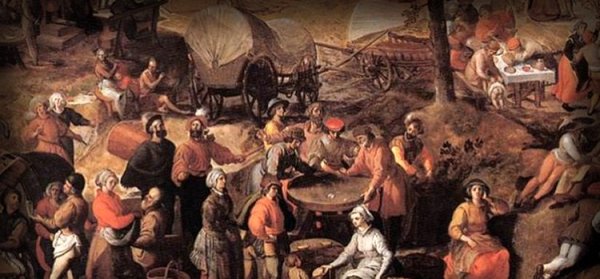
An illustration of a medieval fair.
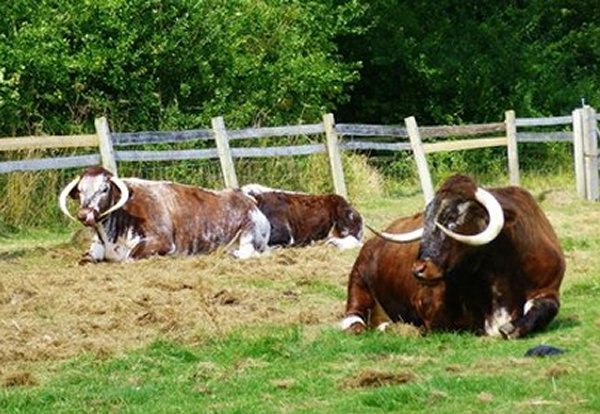
.... and just in case you wanted to know what the dying breed of "rother cattle" looked like.
The word 'rother' is an old Anglo-Saxon word for cattle. The rother cattle were long-horned, fleshy beasts prized for their meat, milk, hide and horn.
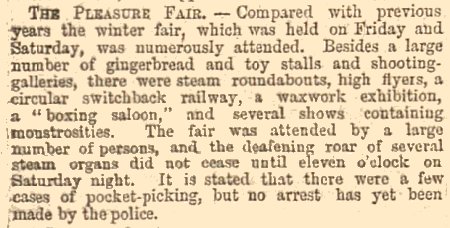
This item, from the 25 November 1892 edition of the Western Gazette, gives a good listing of the attractions offered at the fair that year.
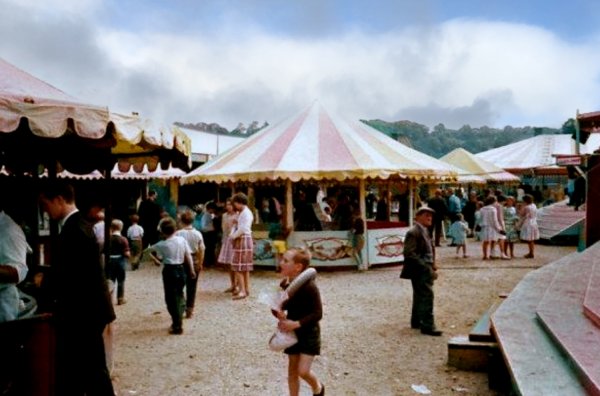
The modern idea of a fair on Fairfield in a colourised photograph of the mid-1960's.
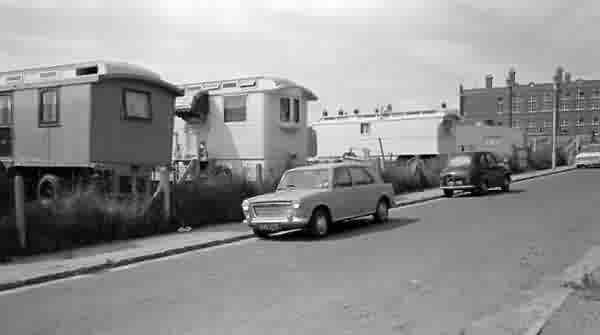
The caravans of the fairground workers are parked in the Fairfield while the fair is set up in the 1960s.
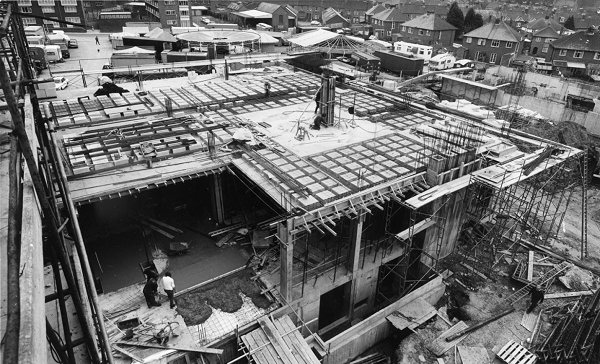
An unusual photograph of 1972 showing Fairfield with the Post Office sorting office being constructed in the foreground and the fair set up in the background.
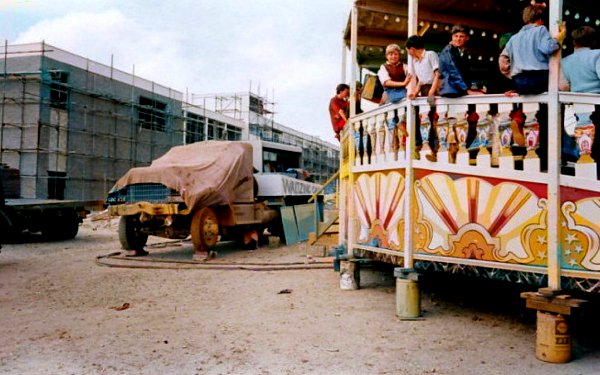
Also photographed (colourised) in 1972, the new Post Office sorting office (seen scaffolded at left) reduced the amount of space for the fair. The fair would soon move to occupy Old Town Station car park for several years during the 1970s and early 1980s.